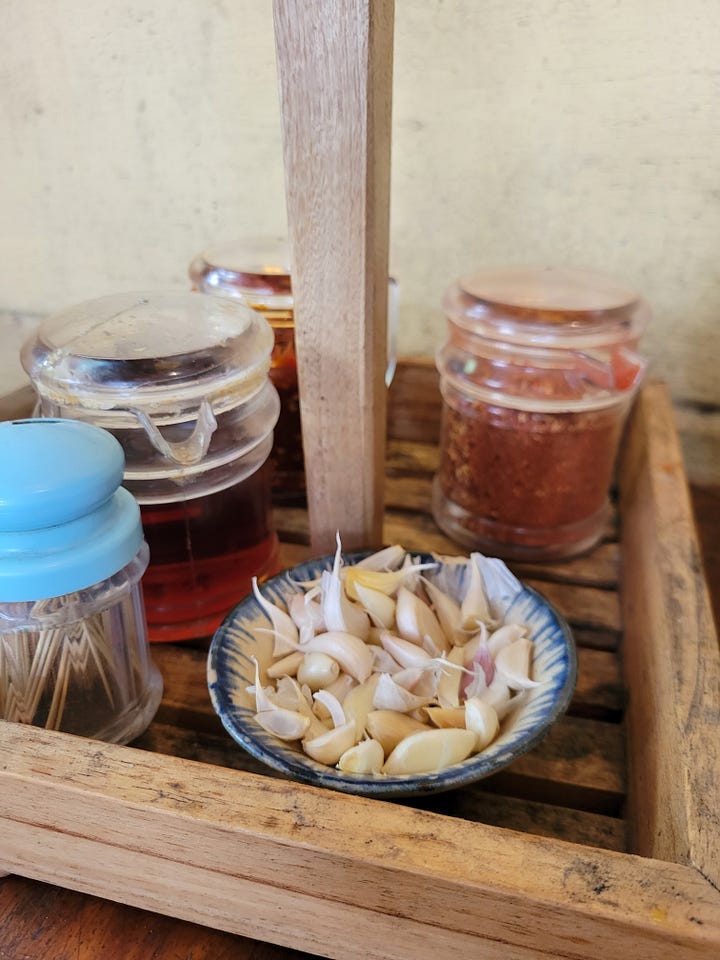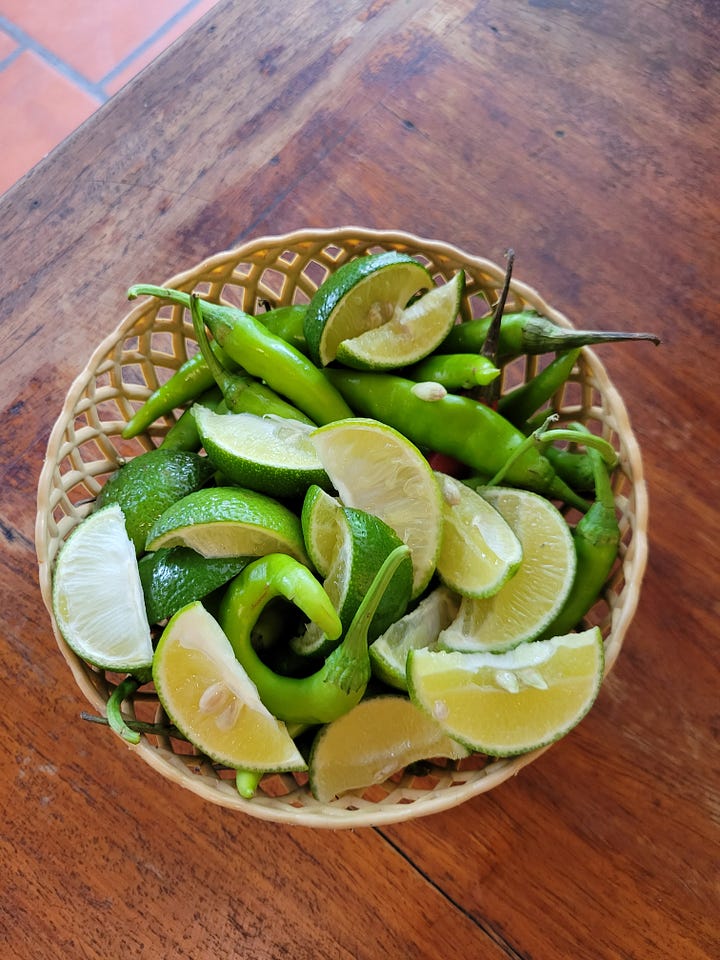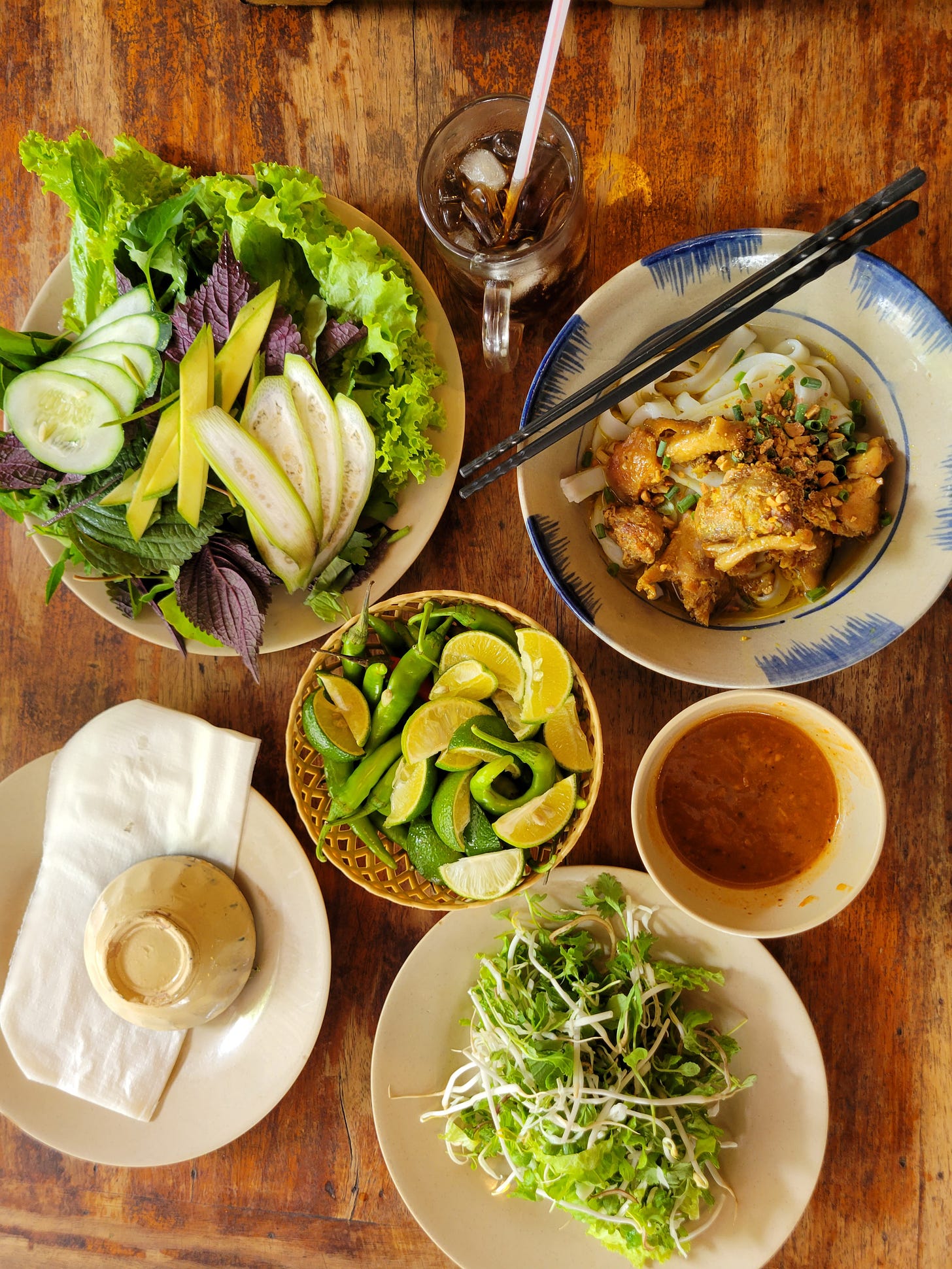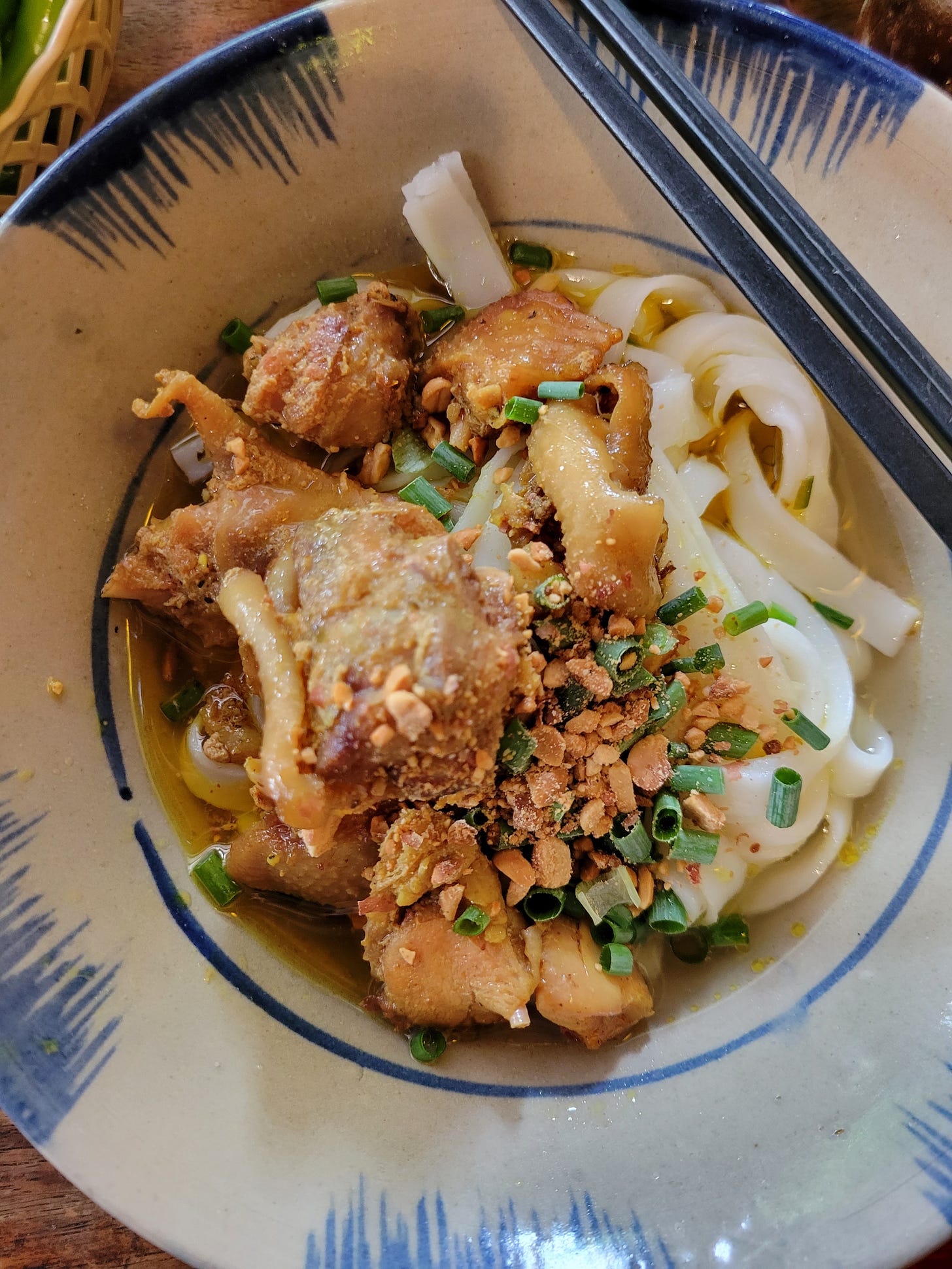We arrived in Da Nang which sits between Ho Chi Minh City (where we started) and Huế (where we were going) with a heavy thud of jet lag. The feeling of jet lag is like existing in a subtle and prolonged state of low-frequency confusion, and decisions are made in a paradoxical state of dysfunction and flow. It feels like we’ve reverted back to infancy. Sometimes you take an accidental 6-hour nap in the mid-afternoon, sometimes you cry over a diss-satisfying meal, and sometimes you’re in a cycle of giggle fits over a silly word. And like a child, the best way to evade a tantrum is with food, so in a hazy dreamlike daze, we venture into Da Nang for lunch.
Once in the cab, we found our way to Mon Quang Mau, a shaded noodle house that was a welcome sanctuary from the swelling tropical heat. Once seated, I clocked an immediate culinary green flag: whole garlic cloves and fresh chilis and limes on the table as a garnish, sitting seductively in a small bowl next to the chopsticks and chili oil. Come and get me, they whispered. Soon my pretties, soon. Unknown to me when I first arrived, Mon Quang Mau’s specialty is mì quảng, a Vietnamese noodle dish that originated in this central region of Vietnam known as Quảng Nam, some say even in Da Nang, though the exact origin story has long been forgotten over time. Like most places we eat while traveling, the best ones are found by chance, not research. We leave it to the food gods to guide us and have yet to be disappointed.


The menu was divided into sections: noodles, combos, pancakes, and hand rolls. I choose noodles, which are forever and always the way to my heart. Within the noodle section, I land on chicken noodles, or mì quảng gà. “With bones or without bones?” I’m asked to choose. Some debatably wiser eaters would say that they don’t want to have to fight with their food to eat it, and so will advise choosing the boneless option.
But I, I'm afraid, am not as wise because I hail from the delicious land of Oregon where working for food usually comes in the form of deshelling or boning seafood. Yes, it’s arduous, but the reward is usually well worth the effort. I’m thinking a chicken leg will arrive, maybe a thigh? But at Mon Quan Mau, this is not the case. Their chicken with bones is, and I’m guessing here, chopped-up chicken spine perhaps? Hard and cylindrical bones wrapped in bands of fat, gristle, and some meat. Does that not sound appealing to you? Well, there you would be surprised. Although it’s more difficult to eat with less meaty reward than the Dungeness crabs that I’m used to battling, the flavor was robust, and savory, with a gentle golden warmth that is unmistakably turmeric. I gnaw and suck on those bones, carefully shredding what meat and flavor I could get, and dropping the rest directly back into the bowl of noodles, knowing it will take me a few attempts to completely give up on the savory boney bits. Although one may get less meat eating off the bones, there is potent flavor found from sucking the bones of its meat and marrow.
With just enough broth to partially cover the noodles and chicken, it is not quite a soup. Mì quảng is served slightly colder than hot soup to match your body temperature which perhaps helps to regulate your internal thermometer on extreme weather days. If anything, the subtle warmth on my tongue is more likely from the ginger and turmeric than the heat of the soup. I slurp the noodles with glee, savoring the perfectly gentle and soft chewiness of their texture and the robust savory aroma of the broth.
The whole dish is completed with a topping of peanuts and diced scallions which adds both a salty crunch, and a bright green crispness to each bite. Lunch is served with a side of red chili dipping sauce, this establishments version of nước chấm. From tasting it, my guess is that it’s a slurry of chili peppers, garlic, sesame paste, fish sauce, sugar, and lime. It’s the color of brick, has a jammy consistency, and is one of the best dipping sauces I’ve ever had. One thing I love about Vietnamese cuisine is its ability to encompass each major taste category within a single bite. This nước chấm sauce is sweet, sour, salty, and savory with an umami flavor that is kissed with a gentle heat. It flirts with spicy but doesn’t quite cross that line. I’m tempted to indulge in it and smother each bite, but I refrain out of respect for the flavors and the preparation of my mì quảng.
While eating off the bone may lack meat, it does not mean that it lacks sustenance. Bone-in eating requires your attention. You are forced to really savor the experience, focus on what and how you’re eating, and be intentional with each bite to extract as much protein and nutrients as possible. At age 34, I only now realize that I have spent the majority of my meals as a distracted eater. I eat with haste, typically taking another bite before the first has even been fully chewed. I eat while watching a show or a movie, absent-mindedly chewing, giving my complete focus to what’s on-screen rather than the food in front of me. This mì quảng, however, cannot be ignored. Each bone must be carefully and tactfully gnawed. One wrong bite and bone shards could end up in uncomfortable places, a tendon could pop loose and make its way down my esophagus. If the noodles are slurped too haphazardly, the delicious turmeric-infused oily broth will forever be remembered as a stain on my shirt.
Once my chicken and noodles have my full attention as if in a state of meditation, my mind goes deeper into the dish. I let my thoughts wander back through history, thinking of how regional and communal dishes like this one came to be and how they have endured thousands of years, dynasties, and wars. Like the land and the sea, it’s a dish that seems to have always existed in this region, a part of this area’s culinary history so old that its origin story has been lost over the centuries. This food tastes nostalgic even when I am a foreigner to this land. Each bite gives a robust story of the generations of ancestors whose work, skill, and history were stirred, chopped, and simmered into a recipe, and inherited through the generations. The same fragrant golden broth, chewy rice noodles, and available protein have always been the holy trinity of mì quảng. Governments inevitably change, but some traditions, especially those related to cuisine, have a permanence that endures.
This lunch break in Da Nang became a meditation and education for me. I’d never heard of mì quảng before that hazy, jet-lagged day. I knew nothing of its history or its connection to the region. Like many before, I was just another hot and hungry traveler seeking respite from the heat. Perhaps it was the medicinal nature of turmeric, garlic, and other ancient herbs and spices, or maybe it was my current state of delirium, but this particular bowl of mì quảng felt healing to me. My jet lag wasn’t cured, it wasn’t any less hot out (the opposite in fact), yet similar to the blissful glow I feel after meditating or a massage, I felt a tingle of peaceful calm gradually take over my mindset. I felt a swell of gratitude to be sitting in this place, at this moment, to have experienced this meal, and to now be connected to this land through their ancestral cuisine.





